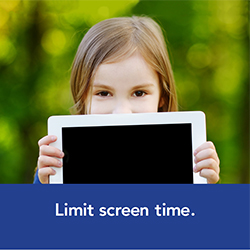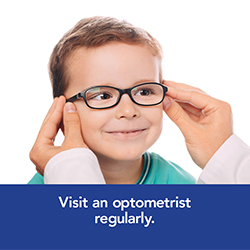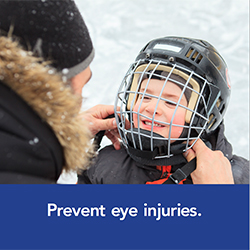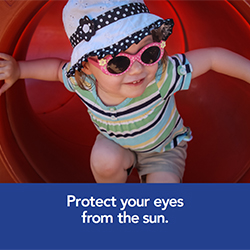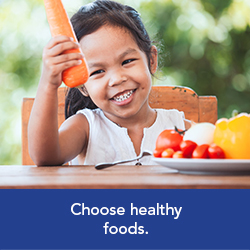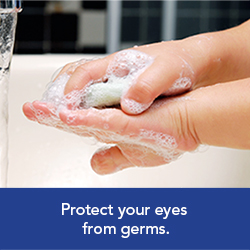Did you know?
1 in 4 school-aged children in Canada has a vision problem.
Children need healthy eyes to learn, read, write, see the board, be active and stay safe. It can be difficult to spot vision problems in children and left untreated, vision problems can affect a child's eye health for life.
Click on each image to learn more:
Screen Time and Vision Health
Set limits for screen time and be a good example by using healthy screen time habits. Take 5-minute breaks for screen sessions longer than 30-45 minutes, use good lighting to reduce glare on screens and ensure viewing distance is not too close (at least 30-40 cm).
Screen time recommendations:
- children under 2 years - not recommended
- children 2 to 5 - less than 1 hour per day is recommended
- children 5 to 18 - no more than 2 hours per day
Spending time on screens means children spend less time outside, which can increase a child’s risk of developing nearsightedness.
Resources
Visit an Optometrist Regularly
Taking care of your child's eyes is important!
Every year in Ontario, 15,000 children have trouble learning to read just because they need glasses. 7,000 children lose the use of one eye because they have an eye problem that is not treated in time.1
Undetected and untreated vision problems often cause reading difficulties and can cause the same signs and symptoms that are commonly attributed to issues such as ADHD, dyslexia and speech problems.2
The Ontario Association of Optometrists (OAO) recommends children have comprehensive eye exams at 6 months old, before starting kindergarten and annually each school year. In Ontario, yearly exams for children are covered by OHIP until they turn 20 years old.
Find an eye doctor near you at Find an Eye Doctor.
Resources
Eye Safety
How can I Protect my Child’s Eyes From Injury?
- Make sure your child wears a helmet with a face mask or wire shield during hockey and other high-impact sports.
- Read all warnings and instructions on toys and avoid toys that shoot pellets, arrows, paintballs or other projectiles.
- Be aware of items in playgrounds and play areas that pose potential eye hazards.
- Store all hazardous household products out of the reach of children. Most children’s eye injuries happen at home, while they are playing or participating in sports.
- Set an example by using protective eyewear during sporting and leisure activities.
Resources
Sun Exposure and Eye Health
Children are at an increased risk of the harmful effects of the sun’s UV rays. Their eyes are still developing and cannot filter sunlight properly. Up to 80% of a person’s lifetime exposure to harmful UV rays occurs during childhood.
Here’s how you can protect your child’s eyes from the sun:
- Choose close-fitting, wraparound style sunglasses that block 100% of UV rays.
- Teach your child to never look directly into or stare at the sun.
- Have your child wear a wide-brimmed hat or baseball cap when outdoors.
- Keep children younger than 6 months out of direct sunlight.
Resources
- Sun and UV exposure (Ontario Association of Optometrists)
- Are all sunglasses created equal? (Canadian Association of Optometrists)
Play Outside Every Day
All outdoor activities can keep your eyes healthy! Research suggests outdoor playtime can lower a child's risk of developing myopia (nearsightedness). Children who spend less time outside are at a higher risk of developing nearsightedness.
Resources
Nutrition and Eye Health
Eating healthy is good for your whole body – especially your eyes! Maintaining a well-balanced diet rich in vitamins and minerals can keep your eyes healthy and reduce your risk for developing certain eye conditions. Foods rich in vitamins, antioxidants, and omega-3s can help protect your eyes. These include:
- berries
- kiwis
- bell peppers
- leafy greens
- sweet potatoes
- fish
- nuts
Drink lots of water to keep your eyes hydrated.
Resources
- Five Snacks for Healthier Eyes (Canadian Association of Optometrists)
- Nutrition - Eye Food Information (Canadian Association of Optometrists)
Protect Your Eyes From Germs
To ensure germs don’t reach your child’s eyes, encourage regular hand washing with soap and warm water. Hand washing should be done:
- after using the washroom
- before eating or preparing food
- after sneezing or coughing
- after playing outside
- after coming home from school or childcare
- after playing with animals or pets
Eye infections are the most common eye-related problem experienced by children visiting the emergency department in Thunder Bay and District.
Resources
For Further Information
If you require more information, including help finding an optometrist, please contact the Children's Visual Health Program at (807) 625-5984 or toll-free at 1-888-294-6630.
